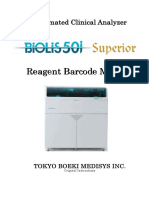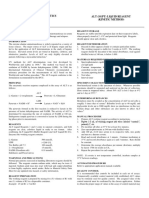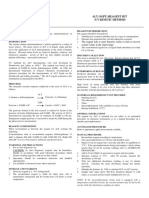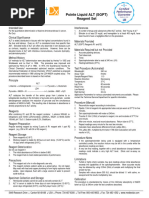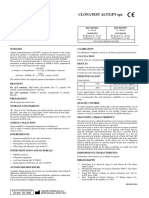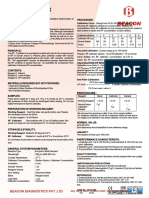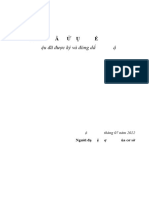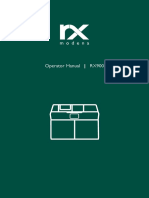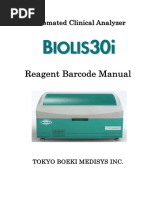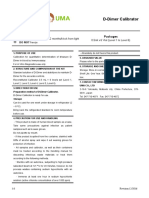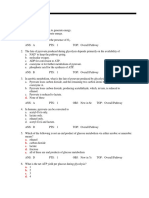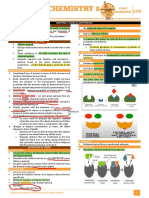0 ratings0% found this document useful (0 votes)
93 viewsMEASURE ALT (Fixed)
MEASURE ALT (Fixed)
Uploaded by
Trần Văn Bình1. This document provides instructions for a reagent kit used to measure alanine aminotransferase (ALT) levels in serum or plasma samples.
2. The kit uses two reagents, R1 and R2, which contain substrates and enzymes, to catalyze a reaction that converts ALT into pyruvate and glutamate. The rate of this reaction is measured to determine ALT concentration.
3. Instructions are provided for sample collection and storage, reagent preparation, operation on automatic analyzers from various manufacturers, quality control, performance characteristics, and safety information.
Copyright:
© All Rights Reserved
Available Formats
Download as DOCX, PDF, TXT or read online from Scribd
MEASURE ALT (Fixed)
MEASURE ALT (Fixed)
Uploaded by
Trần Văn Bình0 ratings0% found this document useful (0 votes)
93 views2 pages1. This document provides instructions for a reagent kit used to measure alanine aminotransferase (ALT) levels in serum or plasma samples.
2. The kit uses two reagents, R1 and R2, which contain substrates and enzymes, to catalyze a reaction that converts ALT into pyruvate and glutamate. The rate of this reaction is measured to determine ALT concentration.
3. Instructions are provided for sample collection and storage, reagent preparation, operation on automatic analyzers from various manufacturers, quality control, performance characteristics, and safety information.
Original Title
MEASURE ALT ( fixed )
Copyright
© © All Rights Reserved
Available Formats
DOCX, PDF, TXT or read online from Scribd
Share this document
Did you find this document useful?
Is this content inappropriate?
1. This document provides instructions for a reagent kit used to measure alanine aminotransferase (ALT) levels in serum or plasma samples.
2. The kit uses two reagents, R1 and R2, which contain substrates and enzymes, to catalyze a reaction that converts ALT into pyruvate and glutamate. The rate of this reaction is measured to determine ALT concentration.
3. Instructions are provided for sample collection and storage, reagent preparation, operation on automatic analyzers from various manufacturers, quality control, performance characteristics, and safety information.
Copyright:
© All Rights Reserved
Available Formats
Download as DOCX, PDF, TXT or read online from Scribd
Download as docx, pdf, or txt
0 ratings0% found this document useful (0 votes)
93 views2 pagesMEASURE ALT (Fixed)
MEASURE ALT (Fixed)
Uploaded by
Trần Văn Bình1. This document provides instructions for a reagent kit used to measure alanine aminotransferase (ALT) levels in serum or plasma samples.
2. The kit uses two reagents, R1 and R2, which contain substrates and enzymes, to catalyze a reaction that converts ALT into pyruvate and glutamate. The rate of this reaction is measured to determine ALT concentration.
3. Instructions are provided for sample collection and storage, reagent preparation, operation on automatic analyzers from various manufacturers, quality control, performance characteristics, and safety information.
Copyright:
© All Rights Reserved
Available Formats
Download as DOCX, PDF, TXT or read online from Scribd
Download as docx, pdf, or txt
You are on page 1of 2
UMA CO., LTD.
MEASURE ALT (SGPT)
2-19-6 Yokosuka Reagent for measuring Alanine aminotransferase
Matsudo, Chiba, Japan JSCC Method
2 ~ 8 °C IVD In vitro Diagnostics Packages
R1: 90 mL R2: 30 mL
DO NOT freeze 18 months/block from light R1: 60 mL R2: 20 mL
1. PURPOSE OF USE glutamate.
In vitro Determination of Alanine aminotransferase (ALT) activity Lactate dehydrogenase (LDH) catalyzes the reduction of pyruvate
in serum or plasma. and the simultaneous oxidation of NADH to NAD+. Activity of ALT
can be determined by measuring the rate of decrease of this
2. GENERAL INSTRUCTION
NADH.
1. For in vitro diagnostics use only.
2. Diagnosis should be made in a comprehensive manner, in L-alanine + α – ketoglutarate ALT
→
accordance with other related test results and clinical symptoms
Pyruvate + L-Glutamate
by the doctor in attendance.
3. For guaranteed results, usage of this product must comply with Pyruvate + NADH + H +
LDH L- Lactate + NAD +
+ H2O
→
the instruction in this manual.
4. Follow the automatic analyzers instructions carefully.
7. CALCULATION & UNIT CONVERSION
3. MATERIALS REQUIRED BUT NOT INCLUDED
Calculation
- Saline 0.9 % and high grade purified water
- Calculate ∆Abs of specimen & standards vs blank
- Micropipet and other basic laboratory equipment.
- Plot a calibration curve ALT (U/L) = f(∆Abs)
- Calibrators and Controls (separatedly sold)
- Calculate ALT concentration in specimen using the curve (doing
4. REAGENT COMPOSITION & PREPARATION
same procedure for Controls)
- Reagent R-1: L-alanine; NADH; LDH
Unit conversion
Reagent R-1 is ready for use
1 U/L = 0.017 µkat/L
- Reagent R-2: L-alanine; α-ketoglutaric acid
8. PERFORMANCE & CORRELATION TEST
Reagent R-2 is ready for use
Performance
- Calibrators: K.Factor calibration (Hitachi 7180 K. -4251)
- Sensitivity: Change in absorbance when using purified water is
- Controls Lyo-1 & Lyo-2 (separatedly sold): Put 1 mL of purified
below 0.001 ~ 0.012/min. and change in absorbance using
water to the vials of controls (L, H); leave at room temparature for
solution (ALT 1000 IU/L) as sample is 0.100 ~ 0.300 /min.
30 minutes before use. After reconstituted, controls can be use
- Specificity: The accuracy is within ±10.0%.
without dilution.
- Reproducibility: CV value < 10.0%.
5. SAMPLE PREPARATION & STORAGE
- Measuring range: 3 ~ 1000 U/L.
- Serum: Wait until sample completly coagulated. Take the
Reference Material for Calibration
supernatant to use as specimen.
ReCCS JCCLS CRM-001
- Plasma: Treat sample by anticoagulant; leave sample to stand
9. EXPECTED VALUES
for 3 hours or centrifuge at 2000 rpm for 2 minutes; take the
- Male: 8 ~ 42 U/L
plasma layer (supernatant) and use as specimen.
- Female: 6 ~ 27 U/L
- Analyze sample soon after collection. In case, it could not be
Reference range should be established at each facility and
analyzed soon, store sample 2 ~ 8 C and analyze within 3 days.
judgement should base on measurement results in a
6. MEASUREMENT PRINCIPLE
comprehensive manner together with clinical symptoms and other
ALT catalyzes the transfer of the amino group of L-alanine to α-
measurement results.
ketoglutarate and resulting in the formation of pyruvate and L-
1/2 Revision 11/2013
10. INTERFERENCES 2. Do not use the container and auxiliaries included in this kit for
- Influence of ascorbic acid of 50 mg/dL, conjugated bilirubin of 20 other purposes.
mg/dL, or hemoglobin of 190 mg/dL to the sample of ALT 40 U/L 3. Do not mix reagents of different lot for use.
is within 10%. 4. Do not add to the reagent being used even if it is the same lot
- Avoid to use hemolyzed specimen. number.
Disposal
11. INFORMATION FOR AUTOANALYZERS
1. All specimens, as well as all instruments (e.g. test tubes) that
For Hitachi Analyzers
come in contact with the specimens, must be treated by the
Calculation Method Rate
following methods, or they must be treated according to the
Temperature 37 C
Specimen 8.5 manual for infectious medical waste provided in each facility.
Volume (μL) R1 150 ・ Sterilize with an autoclave, subjecting them to high pressure
R2 50 saturated steam at 121 °C for more than 20 minutes. Do not
Main 340 process waste containing sodium hypochlorite solution with an
Wavelength (nm)
Sub- 600 autoclave.
Point 1 10
Measurement ・ Immerse at least one hour in sodium hypochlorite solution
Point 2 21
(cycle) (active chloride concentration of over 1000 ppm).
Point 3 34
2. This reagent contains sodium azide. Sodium azide can react
Calibration type K: -4251
with lead pipe and/or steel pipe and can generate explosive metal
Unit U/L
azide. Make sure to use plenty of water at disposal. Concentration
of sodium azide in R-2 is 0.05%.
For Beckman Coulter Analyzers
Calculation Method Rate 13. OTHER INSTRUCTIONS AND CAUTION
Temperature 37 C - Results may differ depending on the sample/reagent ratio.
Specimen 8.5 Adjust parameters for different analyzer.
Volume (μL) R1 150 - Prepare the calibration curve on the day of determination.
R2 50
Main 340
Wavelength (nm)
Sub- 600
Point 1 14
Measurement Point 2 27
(cycle) Point 3 -
Point 4 -
Calibration type Linear
Unit U/L
12. HANDLING, USAGE & DISPOSAL
Handling
1. Specimen can be potentially positive for infectious agents
including hepatitis B virus and HIV. Wear glove and goggle when
needed.2. In case reagents got into skin, eye or mouth by mistake,
wash it immediately with plenty of water and consult the doctor if
needed.
3. If reagents are spilled, dilute with water and wipe it out. If
specimen is spilled, spray 80% of alcohol over the specimen and
wipe it out.
Usage
1. Store reagents under specified condition. Do not use after
expiration date.
2/2 Revision 11/2013
You might also like
- The Poor Lab's Guide To The RegulationsDocument5 pagesThe Poor Lab's Guide To The RegulationsLeonardo HernandezNo ratings yet
- SGPT (ALT) - Kit InsertDocument2 pagesSGPT (ALT) - Kit InsertDharmesh Patel100% (1)
- BiOLiS 50i Reagent Barcode M Ver1.04 20150401Document20 pagesBiOLiS 50i Reagent Barcode M Ver1.04 20150401Trần Văn BìnhNo ratings yet
- Teco Diagnostics: Alt (SGPT) Liquid Reagent (Kinetic Method)Document2 pagesTeco Diagnostics: Alt (SGPT) Liquid Reagent (Kinetic Method)Wendy ZacaríasNo ratings yet
- BM800 Service Manual 2014 LR PDFDocument168 pagesBM800 Service Manual 2014 LR PDFjuanpabloplusNo ratings yet
- Alanine Aminotransferase (Alt-Gpt)Document1 pageAlanine Aminotransferase (Alt-Gpt)Risqon Anjahiranda Adiputra67% (3)
- Dirui PDFDocument36 pagesDirui PDFДарко МаксимовићNo ratings yet
- Biological Chemistry. The Bank of MCQ Test Questions) 2016-2017Document32 pagesBiological Chemistry. The Bank of MCQ Test Questions) 2016-2017AGM EB100% (1)
- MEASURE AST (Fixed)Document2 pagesMEASURE AST (Fixed)Trần Văn BìnhNo ratings yet
- SGPT CrestlineDocument2 pagesSGPT CrestlineJashmyn JagonapNo ratings yet
- Measure AmyDocument2 pagesMeasure Amytuan vănNo ratings yet
- Measure UnDocument2 pagesMeasure Untuan vănNo ratings yet
- MEASURE TP (Fixed)Document2 pagesMEASURE TP (Fixed)Trần Văn BìnhNo ratings yet
- Measure TbaDocument2 pagesMeasure Tbatuan vănNo ratings yet
- GPTDocument2 pagesGPT徳利雅100% (1)
- Measure NagDocument2 pagesMeasure Nagtuan vănNo ratings yet
- KIT INSERT ALT GPTDocument2 pagesKIT INSERT ALT GPTmustakim gmaNo ratings yet
- Budi Altgpt - Doc NewDocument3 pagesBudi Altgpt - Doc NewIrvanda ENVIOUSNo ratings yet
- 1105000I Rev. 02Document2 pages1105000I Rev. 02Riadh BenyoucefNo ratings yet
- 1141010I Rev. 02Document2 pages1141010I Rev. 02Nguyễn HuynhNo ratings yet
- A7526-01 - AltDocument2 pagesA7526-01 - AltSiva Kumar KNo ratings yet
- Mxbeis27 Amilase 2017Document4 pagesMxbeis27 Amilase 2017Gabriel99601 [Rapidos y Rabiosos] BkknNo ratings yet
- MEASURE GLU (Fixed)Document3 pagesMEASURE GLU (Fixed)Trần Văn BìnhNo ratings yet
- AmylaseDocument1 pageAmylasePhong Nguyễn WindyNo ratings yet
- Alt (SGPT) Liquid Reagent: Do Not Use Reagent IfDocument2 pagesAlt (SGPT) Liquid Reagent: Do Not Use Reagent IfSULAB MARACAIBONo ratings yet
- Got-Lq: NADH. Kinetic UV. IFCC Rec - LiquidDocument1 pageGot-Lq: NADH. Kinetic UV. IFCC Rec - LiquidNawelNo ratings yet
- 1126005I Rev. en KR 04Document2 pages1126005I Rev. en KR 04Nguyễn HuynhNo ratings yet
- Measure H-FabpDocument2 pagesMeasure H-Fabptuan vănNo ratings yet
- Measure GluDocument2 pagesMeasure Glutuan vănNo ratings yet
- CT10052Document4 pagesCT10052KOUAME EDYMAIN FRANCISNo ratings yet
- Yazz Gtp/altDocument2 pagesYazz Gtp/altFlorence ToroNo ratings yet
- Clonatest Alt/Gpt OptDocument4 pagesClonatest Alt/Gpt OptSuprovet LabotatorioNo ratings yet
- 732 CT10052Document2 pages732 CT10052thureinwinnNo ratings yet
- 1120005I Rev. 02Document2 pages1120005I Rev. 02samirsama794No ratings yet
- MEASURE D-BilDocument2 pagesMEASURE D-Biltuan vănNo ratings yet
- Measure UaDocument2 pagesMeasure Uatuan vănNo ratings yet
- Lipase Spinreact 1x24 ML, 1X48 MLDocument2 pagesLipase Spinreact 1x24 ML, 1X48 MLN. K. MandilNo ratings yet
- MEASURE HbA1c (Fixed)Document2 pagesMEASURE HbA1c (Fixed)Trần Văn Bình100% (1)
- D03099 - TGP MonochromatiqueDocument2 pagesD03099 - TGP MonochromatiqueKOUAME EDYMAIN FRANCISNo ratings yet
- Total Protein SPDocument3 pagesTotal Protein SPsaraNo ratings yet
- Measure TCDocument2 pagesMeasure TCtuan vănNo ratings yet
- 1151010I Rev. 04Document2 pages1151010I Rev. 04kirubel demelashNo ratings yet
- Urea PDFDocument2 pagesUrea PDFJon RiverNo ratings yet
- SGOT CrestlineDocument2 pagesSGOT CrestlineJashmyn JagonapNo ratings yet
- MEASURE D-DimerDocument2 pagesMEASURE D-Dimertuan vănNo ratings yet
- Gpt-11-Alt (GPT) Uv 2V-02,12,2014 - 5Document2 pagesGpt-11-Alt (GPT) Uv 2V-02,12,2014 - 5dung nguyen danhNo ratings yet
- Alanine Aminotransferase (ALT or SGPT)Document1 pageAlanine Aminotransferase (ALT or SGPT)tuan vănNo ratings yet
- MEASURE CRE (Fixed)Document3 pagesMEASURE CRE (Fixed)Trần Văn BìnhNo ratings yet
- RF TurbilatexDocument1 pageRF TurbilatexSud007jbNo ratings yet
- GPT (Alt) : NADH. Kinetic UV. IFCC RecDocument1 pageGPT (Alt) : NADH. Kinetic UV. IFCC RecNawelNo ratings yet
- PHP UYjhb 7Document2 pagesPHP UYjhb 7BerhaneNo ratings yet
- Measure PG IDocument2 pagesMeasure PG INguyen TuanNo ratings yet
- Acid Phosphatase (Acp)Document1 pageAcid Phosphatase (Acp)Risqon Anjahiranda AdiputraNo ratings yet
- ALT480-01Document4 pagesALT480-01Jose GuerraNo ratings yet
- a1-anti tripsina pntDocument4 pagesa1-anti tripsina pntumaps2006No ratings yet
- Altgpt Ise Miura Rev D 05072011 07 2011Document2 pagesAltgpt Ise Miura Rev D 05072011 07 2011To Duy CongNo ratings yet
- Uma Co., Ltd. Measure Alb: 2-19-6 Yokosuka Matsudo, Chiba, Japan Bromocresol Green MethodDocument2 pagesUma Co., Ltd. Measure Alb: 2-19-6 Yokosuka Matsudo, Chiba, Japan Bromocresol Green MethodNguyễn Phương NgọcNo ratings yet
- 6.POTASSIUM EnzymaticDocument2 pages6.POTASSIUM EnzymaticHiếu Chí PhanNo ratings yet
- HDSD Eng LDHDocument3 pagesHDSD Eng LDHtthanhtrungnguyenNo ratings yet
- BSIS77 CREATININA Enzimatica 1001115-17 2011Document2 pagesBSIS77 CREATININA Enzimatica 1001115-17 2011Nghi NguyenNo ratings yet
- GGT InsertDocument2 pagesGGT InsertsharmashyamsinghNo ratings yet
- Creatine Kinase MB (CK MB)Document1 pageCreatine Kinase MB (CK MB)Risqon Anjahiranda Adiputra100% (3)
- Astgot Ise Miura Rev D 05072011Document2 pagesAstgot Ise Miura Rev D 05072011To Duy CongNo ratings yet
- PI-e-AMMU-1 (1)Document2 pagesPI-e-AMMU-1 (1)sharmashyamsinghNo ratings yet
- Quantitative Determination of Alkaline Phosphatase (ALP) IVDDocument1 pageQuantitative Determination of Alkaline Phosphatase (ALP) IVDPhong Nguyễn WindyNo ratings yet
- File - 20230224 - 153859 - 1247ue 2026-01Document66 pagesFile - 20230224 - 153859 - 1247ue 2026-01Trần Văn Bình100% (1)
- RX Modena Operator ManualDocument418 pagesRX Modena Operator ManualTrần Văn Bình100% (2)
- WP Contentuploads202302lyo 2 214ABL PDFDocument3 pagesWP Contentuploads202302lyo 2 214ABL PDFTrần Văn BìnhNo ratings yet
- PI VA0008CCL EN v3Document1 pagePI VA0008CCL EN v3Trần Văn BìnhNo ratings yet
- Cormay Hba Direct: Diagnostic Kit For Determination of Haemoglobin A Concentration Ii GenerationDocument2 pagesCormay Hba Direct: Diagnostic Kit For Determination of Haemoglobin A Concentration Ii GenerationTrần Văn BìnhNo ratings yet
- Ifu 1418 0207 CalciumDocument2 pagesIfu 1418 0207 CalciumTrần Văn Bình100% (1)
- Autosampler Service Manual v1.3Document31 pagesAutosampler Service Manual v1.3Trần Văn BìnhNo ratings yet
- PI VA0000SL EN v3.0Document1 pagePI VA0000SL EN v3.0Trần Văn BìnhNo ratings yet
- A5 Set Up and Start InstructionsDocument6 pagesA5 Set Up and Start InstructionsTrần Văn BìnhNo ratings yet
- Double Scatter or Ghost ScatterDocument3 pagesDouble Scatter or Ghost ScatterTrần Văn BìnhNo ratings yet
- Cleaning The Pressure Sensor V3Document2 pagesCleaning The Pressure Sensor V3Trần Văn BìnhNo ratings yet
- Aquarius-3 Brochure - v3Document3 pagesAquarius-3 Brochure - v3Trần Văn BìnhNo ratings yet
- Abacus 5 Spare Part List 2018Document10 pagesAbacus 5 Spare Part List 2018Trần Văn BìnhNo ratings yet
- Abacus 5 Advanced Networking and LIS Troubleshooting GuideDocument25 pagesAbacus 5 Advanced Networking and LIS Troubleshooting GuideTrần Văn BìnhNo ratings yet
- Ethanol (Biolabo) For Au480, A680Document1 pageEthanol (Biolabo) For Au480, A680Trần Văn BìnhNo ratings yet
- Uma Co., Ltd. Hba1C Diluent: 2-19-6 Yokosuka Matsudo, Chiba, JapanDocument1 pageUma Co., Ltd. Hba1C Diluent: 2-19-6 Yokosuka Matsudo, Chiba, JapanTrần Văn BìnhNo ratings yet
- Aquarius 5dreticDocument4 pagesAquarius 5dreticTrần Văn Bình0% (1)
- Reagent Barcode Manual: Automated Clinical AnalyzerDocument28 pagesReagent Barcode Manual: Automated Clinical AnalyzerTrần Văn BìnhNo ratings yet
- Uma Co., Ltd. Pepsinogen (PG) Calibrator: 2-19-6 Yokosuka Matsudo, Chiba, JapanDocument1 pageUma Co., Ltd. Pepsinogen (PG) Calibrator: 2-19-6 Yokosuka Matsudo, Chiba, JapanTrần Văn BìnhNo ratings yet
- Ecl 760 Fully Automated Random Access Coagulaon AnalyzerDocument2 pagesEcl 760 Fully Automated Random Access Coagulaon AnalyzerTrần Văn BìnhNo ratings yet
- MEASURE D-Dimer (Fixed)Document2 pagesMEASURE D-Dimer (Fixed)Trần Văn BìnhNo ratings yet
- Autoquant 100iautoquant 100 AmaraDocument6 pagesAutoquant 100iautoquant 100 AmaraTrần Văn BìnhNo ratings yet
- Uma Co., Ltd. D-Dimer Control: 2-19-6 Yokosuka Matsudo, Chiba, JapanDocument1 pageUma Co., Ltd. D-Dimer Control: 2-19-6 Yokosuka Matsudo, Chiba, JapanTrần Văn BìnhNo ratings yet
- Uma Co., Ltd. D-Dimer Calibrator: 2-19-6 Yokosuka Matsudo, Chiba, JapanDocument1 pageUma Co., Ltd. D-Dimer Calibrator: 2-19-6 Yokosuka Matsudo, Chiba, JapanTrần Văn BìnhNo ratings yet
- Clinical Chemistry Case AnalysisDocument5 pagesClinical Chemistry Case AnalysisJeatrice CarlosNo ratings yet
- G26interno Brochure PDFDocument6 pagesG26interno Brochure PDFCan ArasNo ratings yet
- Role of Nursing Personnel in Laboratory Testing: August 2018Document6 pagesRole of Nursing Personnel in Laboratory Testing: August 2018John Alexander Hurtado ParraNo ratings yet
- Biochem QuestionsDocument13 pagesBiochem Questionsshalialoo22No ratings yet
- Jurnal Biokimia 1Document10 pagesJurnal Biokimia 1selviNo ratings yet
- Got Ast Beis38 02-2011Document2 pagesGot Ast Beis38 02-2011Guneyden GuneydenNo ratings yet
- Myocardial Infarction and Heart Failure Practice Quiz (70 Questions)Document44 pagesMyocardial Infarction and Heart Failure Practice Quiz (70 Questions)Melodia Turqueza GandezaNo ratings yet
- 075 CalDocument2 pages075 CalWidya Puji ListiyaniNo ratings yet
- Testbank Final-284-322Document39 pagesTestbank Final-284-322khulood almerriNo ratings yet
- Bertil Sjodin Et - Al, 1982 - Changes in Onset of Blood Lactate Accumulation (OBLA) and Muscle Enzymes After Training at OBLADocument13 pagesBertil Sjodin Et - Al, 1982 - Changes in Onset of Blood Lactate Accumulation (OBLA) and Muscle Enzymes After Training at OBLAok okNo ratings yet
- 2016 - Recent Advances in The Synthesis of Layered Double Hydroxide-Based Materials and Their Applications in Hydrogen and Oxygen EvolutionDocument15 pages2016 - Recent Advances in The Synthesis of Layered Double Hydroxide-Based Materials and Their Applications in Hydrogen and Oxygen EvolutionBrandon YorkNo ratings yet
- Liquide PleuralDocument40 pagesLiquide PleuralHăppį ÑəssNo ratings yet
- Interpretation of Cardiac Enzymes:: Test: SGOTDocument4 pagesInterpretation of Cardiac Enzymes:: Test: SGOTMohammed AbdouNo ratings yet
- Why Does My Patient Limphadenopathy or Splenomegaly?Document14 pagesWhy Does My Patient Limphadenopathy or Splenomegaly?lacmftcNo ratings yet
- Inbo13 QuestionDocument40 pagesInbo13 QuestionKalpavriksha1974No ratings yet
- Preeclampsia With Severe Features, Uncontrolled: University of The Cordilleras College of NursingDocument45 pagesPreeclampsia With Severe Features, Uncontrolled: University of The Cordilleras College of NursingAndrei MarcosNo ratings yet
- Distinguishing Reference Intervals and Clinical Decision LimitsDocument13 pagesDistinguishing Reference Intervals and Clinical Decision LimitsJoana BarbosaNo ratings yet
- Equipment Applications BTS 370Document32 pagesEquipment Applications BTS 370oscacaiNo ratings yet
- Biochemistry II Ch. 16 Glycolysis and Gluconeogenesis (MASTER) )Document75 pagesBiochemistry II Ch. 16 Glycolysis and Gluconeogenesis (MASTER) )coco100% (2)
- Ba0001 TM1 PDFDocument4 pagesBa0001 TM1 PDFLiz W. Villarreal WaiwaNo ratings yet
- Clinical Chemistry Review 1 110Document6 pagesClinical Chemistry Review 1 110DELLNo ratings yet
- Clinical Chemistry 2 First GradingDocument25 pagesClinical Chemistry 2 First GradingMHEKAELLA SAMSONNo ratings yet
- Sigma ThoeryDocument8 pagesSigma ThoeryganeshNo ratings yet
- (Mod. IFCC Method) For The Determination of SGPT (ALT) Activity in Serum. (For in Vitro Diagnostic Use Only)Document1 page(Mod. IFCC Method) For The Determination of SGPT (ALT) Activity in Serum. (For in Vitro Diagnostic Use Only)Dinesh SreedharanNo ratings yet
- Normal Hematologic and Serum Biochemical Reference Intervals For Juvenile Wild TurkeysDocument4 pagesNormal Hematologic and Serum Biochemical Reference Intervals For Juvenile Wild Turkeysweldommo2903No ratings yet
- GlycolysisDocument21 pagesGlycolysisAli AlqumaNo ratings yet


